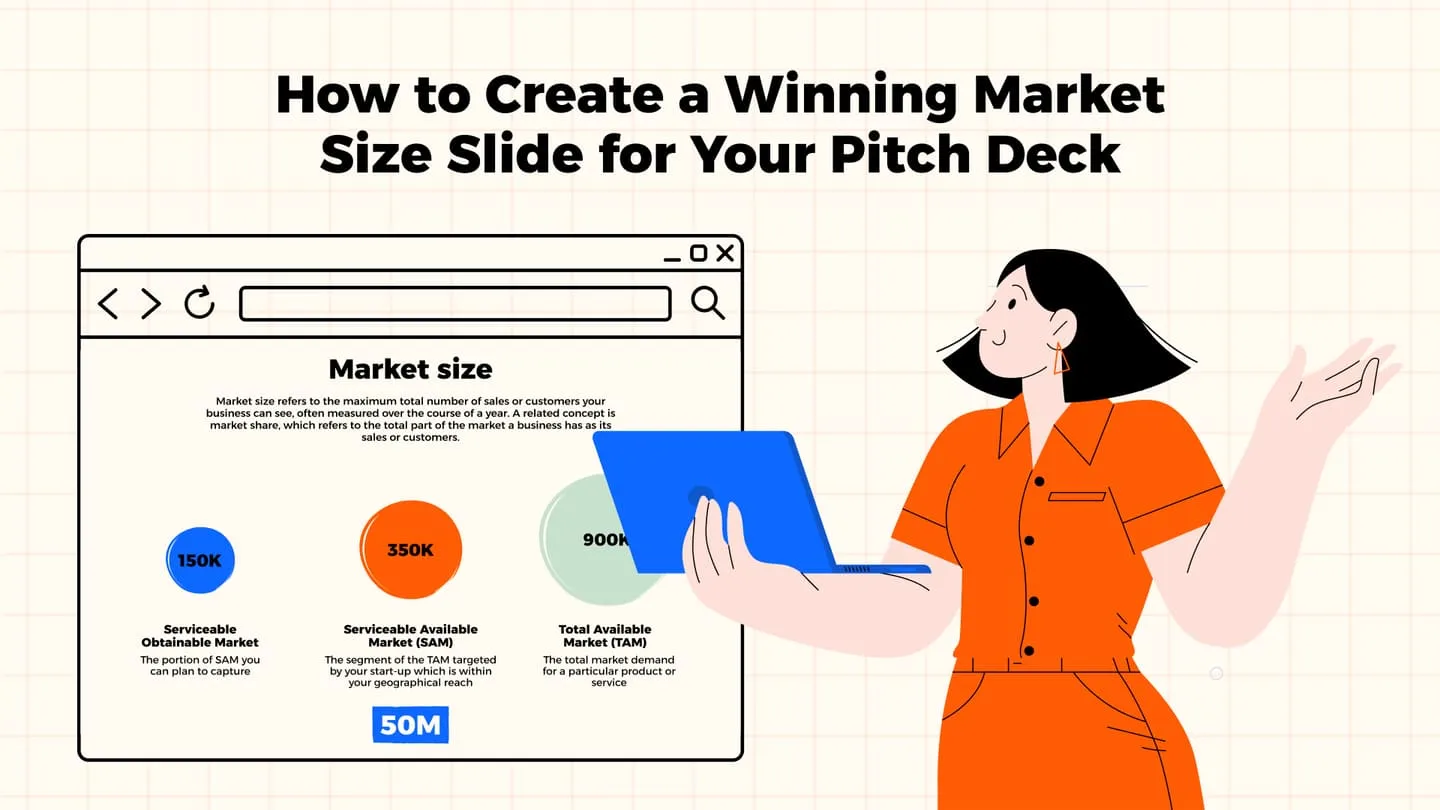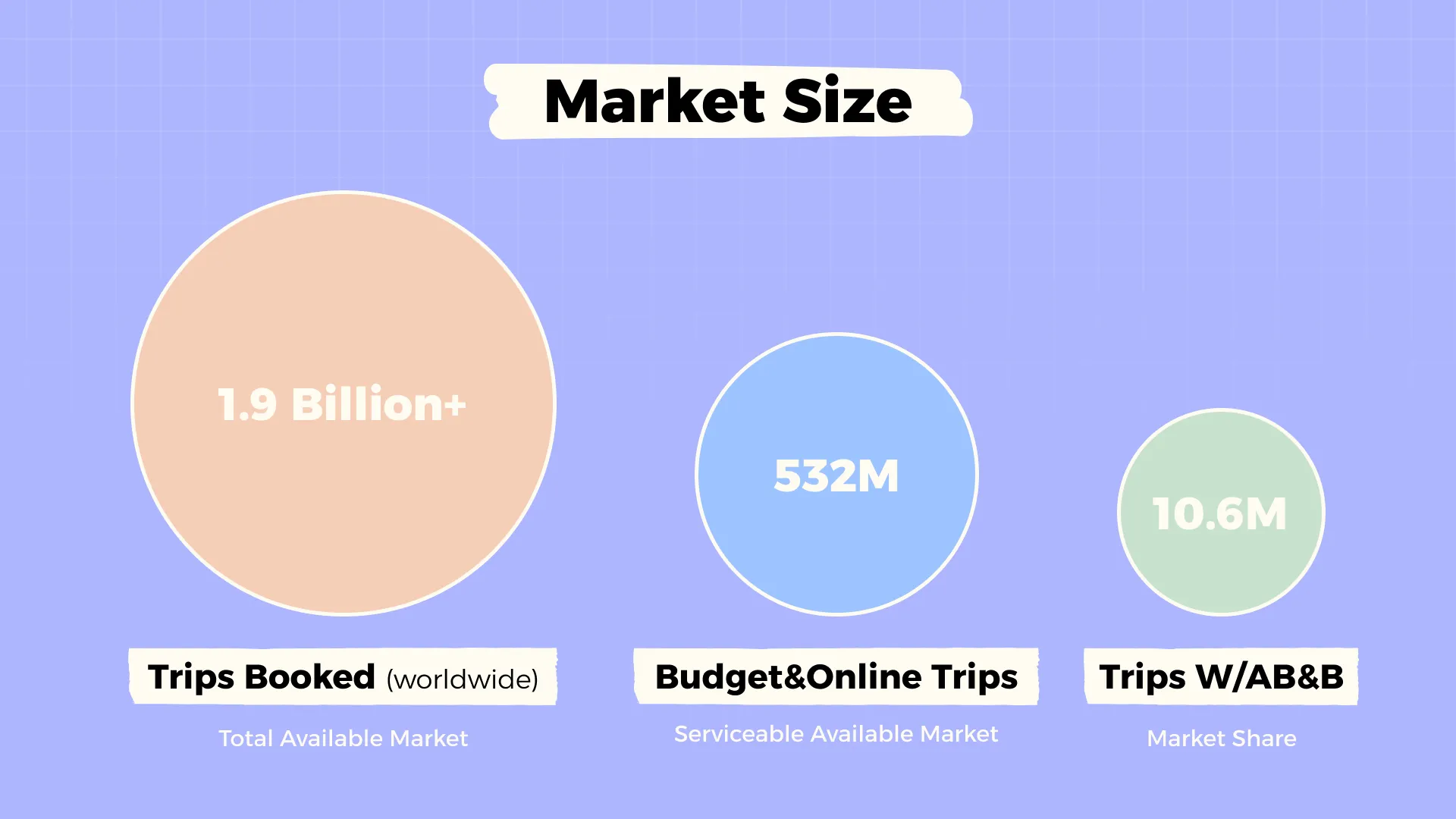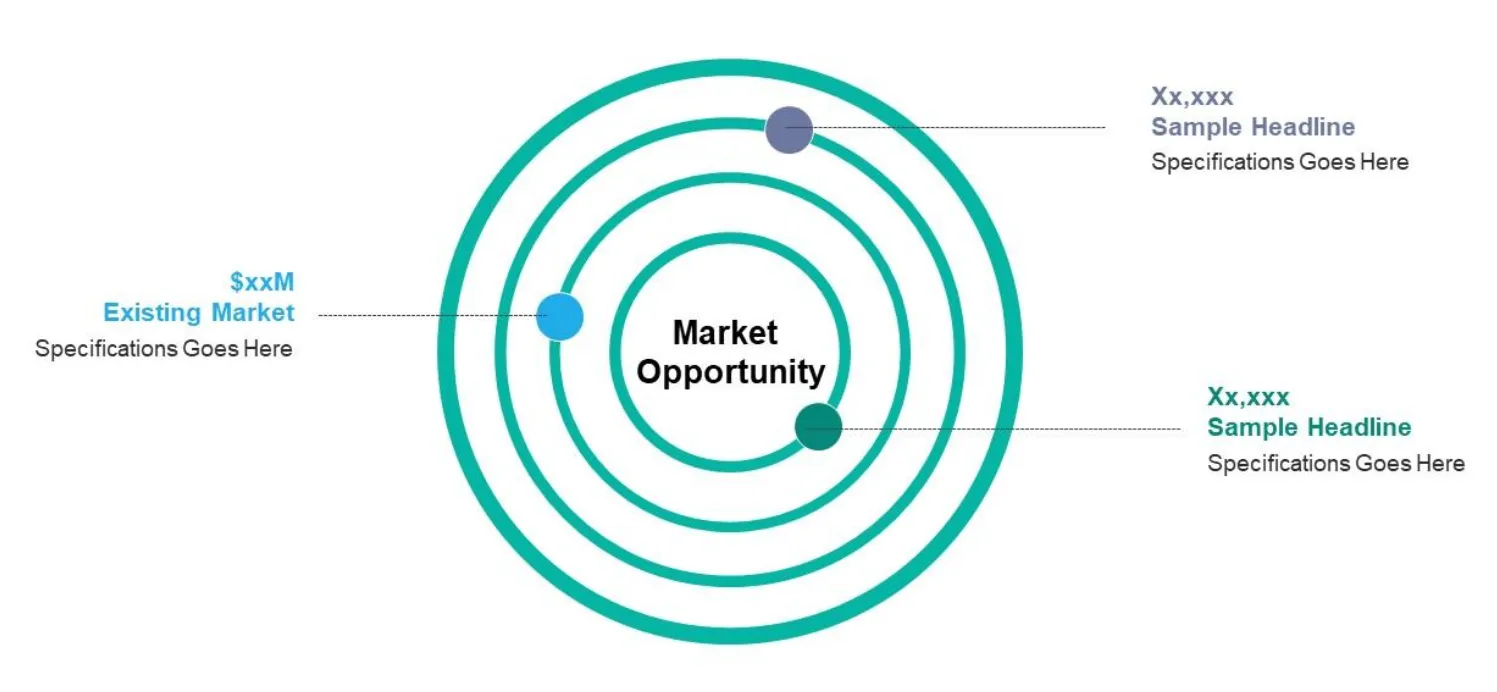
How to Create a Winning Market Size Slide for Your Pitch Deck

You've got a great business idea and crafted a compelling pitch deck to convince investors to fund your endeavor. But how do they know your business has a proven market potential? The answer is from the market size slide. It shows that there exist enough customers ready to pay for the product or service you offer. In this article, we'll dive into how to show market size in pitch deck and what mistakes to avoid to captivate the audience. Read on.
What is a Market Size Slide in Pitch Deck?
Sometimes, all it takes is a single market opportunity slide pitch deck to make or break the funding deal. Market sizing slides are crucial pieces of the puzzle designed to reflect the scope and scale of your business. A well-addressed slide will reflect the existing demand, outline realistic goals, and set a timeframe for well-calculated market expansion. All these factors combined will tell the potential investor how good an investment your offer makes. Simply put, a size slide lets the viewers assess your potential not in theory but in the near future.
Why is the Market Size Slide Crucial?
The market size slide is a paramount component of any pitch deck for two key reasons – building the first impression and influencing the decision-making process. Let's have a closer look at each.
- First Impressions Count
What you should care about most is first impressions. If you have valuable data but fail to represent it the way it captivates the investors’ attention, then consider your business doomed to not get funded. Remember, you only have 40 seconds to impress the audience.
Your market size slide is like an opening statement that sets the tone for the entire pitch deck. It showcases the significance of your startup within the intended market.
- Investor Insight
When you start to examine real-life pitch deck presentation examples, you'll quickly understand that having a well-thought-out idea of a product or service that solves a real problem isn't enough to get funded. Why? To understand this, ask yourself these questions – What if there are only 5 people who really need your solution? What if they aren’t ready to pay for it?
You should be able to sell your solution for enough money to cover the expenses and – most importantly – generate profit. And the potential profit you’re expecting to get is a direct representation of the ROI (Return on Investment) investors are going to obtain. To put it short, with your market overview slide, you want to show you have a clear vision of how the market is expected to grow and how you’re planning to grow within it.
Now, let’s get to the must-have elements of a winning market size slide.
Components of an Effective Market Size Slide
.webp)
Expert business presentation design services usually outline two primary ways to size a market – bottom-up market sizing and top-down market sizing. Bottom-up market sizing is when you rely on existing data from reputable data sources (we’ll talk about them a bit later) and estimate the market’s value. Top-down market sizing is when you focus on a specific market, further expanding to a larger market. The latter proves to be a more realistic approach. However, it is more time-consuming and complex. The top-down approach, on the contrary, is simple and quick but when using it, you may overlook significant details.
An effective market size slide structure comes down to three elements – TAM, SAM, and SOM. Let’s take a look at each and make these jargon words simple for you.
TAM (Total Addressable Market)
TAM focuses on the total demand for your product or service. It represents just a portion of the total market. For more clarity, imagine you’re an electric scooter producer. And your solution is part of the broader transportation market. So in this case, the TAM would be a specific portion of the overall market, that targets users looking for an eco-friendly commuting solution.
To calculate TAM, use this formula:
TAM = Number of customers x Potential price they’re willing to pay
Let’s take electronic scooters as an example and break it down. The total number of customers is around 77 million, according to the latest statistics as of 2022. Let’s assume the price they’re going to pay for the product is $800. The TAM would be 77,000,000 x 800 = 61.6 billion.
SAM (Serviceable Available Market)
SAM is a specific part of the TAM targeted by your solution. This is where you start narrowing things down. SAM is actually the portion of the market you hope to cater to. Sometimes SAM can be limited by a geographical location.
Let’s get back to the example of the electric scooters we used above to represent the notion of SAM. Let’s say your scooters are aimed at urban professionals aged 25-35 who prioritize style. This will be your SAM, i.e., a more specific and attainable group within a broader electric scooter market.
SOM (Serviceable Obtainable Market)
SOM is further narrowed down from SAM. It’s actually the share of the SAM that you can really serve. It’s always smaller than SAM since it takes location, pricing, existing demand, team capacity, competition, sales channels, and things like that into account. Going back to the previous example with the scooters, you can really capture, let’s say, 30% of the identified target market. So, if your SAM is 70,000 urban professionals, then your SOM will be 21,000 (30% of SAM).
It should be noted that you need to focus on short-term goals since SOM focuses on what you can realistically achieve in the near future, meaning you take into account your current capabilities and market conditions.
“Founders often throw in TAM, SAM, and SOM just to add something. But those numbers are useless, in my opinion. How did you get there? That’s what matters.”
Richard Dulude,
Underscore VC Co-founder and Partner
Visual Representation Tips

To captivate investors, you need to not just prepare convincing data but also visualize them properly. So here are the three key tips for a nice TAM slide:
- Use Simple, Clear Charts
You need to strive for a concise and clean market opportunity slide. Leverage pie charts (best for illustrating the percentage breakdown of market segments) and bar charts (best for showcasing numerical comparisons, trends, or rankings) over lists. They are perceived much easier due to a lower cognitive load.
- Avoid Clutter
Don’t clutter your pitch deck market size slide with lots of data just for the sake of numbers. Strive for adequate white space between elements to enhance comprehension and visual appeal. Also, use clear labeling to guide the audience through your slide. Make your labels concise and ensure they are directly related to the data they represent.


3. Use Consistent Branding
Also, pay attention to consistent branding – implementing brand colors, fonts, and themes. This will serve several purposes: reinforcing brand recognition, showcasing professionalism, building credibility, ensuring unified communication, aiding memorability, and creating a harmonious design.
Data Sources and Credibility
Now that you know the elements of a winning total addressable pitch deck market slide, you must be wondering where to get that market data. Well, it only seems difficult. In fact, you can follow the professional industry research services' lead and make use of the available variety of well-known and reputable market research databases:
- Statista. A simple statistics portal for various industries. However, some reports aren’t free, and the prices for paid reports are often too high.
- eMarketer. A resource specializing in digital marketing and commerce. Full access may require a subscription.
- Gartner Research. A renowned global research and advisory firm, offering insights across a range of industries, with a focus on technology and business. The portal offers some free resources but the most valuable insights may be behind a paywall.
When using data from these sources, ensure the insights are up-to-date, relevant, and accurate. This will enhance the credibility of your pitch deck market slide and enable informed decision-making.
Also, you have to always cite the sources you use. First of all, by doing so, you uphold ethical standards, acknowledging and respecting the intellectual property of those providing insights. It also showcases transparency and honesty in presenting data and allows investors to verify your research. Finally, citation serves as a safeguard against plagiarism, preventing the misrepresentation of other people's work as your own.
Here’s a short guide to citing sources on your market sizing slide:
- Include the name of the source
- Specify the author’s name (if applicable) and the publication date
- Include the title of the report/research/study, etc.
- Limit citations to essential information so as not to overwhelm your pitch deck TAM slide
- Write citations in smaller yet readable font in the sidebar or footer
- Stick to the same format for all the sources you use
- Ensure accuracy in the titles, names of the sources, publication year, etc.
Another tip, which is optional but still worth considering is creating a separate slide at the end of your pitch deck with all the references for those who want to explore the sources further.
We covered the Do’s for source citation. And here’s a list of Dont’s:
- Sourced data provides a strong foundation for your information. So, avoid using unsourced data to prevent investors from questioning your data credibility.
- Don’t use data without proper attribution as this may lead to legal consequences. Besides, by failing to cite the sources you used, you put your reputation at risk.
Common Mistakes to Avoid
There are two common mistakes you should be aware of not to spoil your pitch deck:
- Wrong estimates. The greatest mistake you can make when crafting your market sie slide is falling into two extremes. The first one is focusing on smaller data samples and missing opportunities. The other one is venturing into too much growth and neglecting potential limitations. Both approaches can prove detrimental in the long run. So it’s important to strike the right balance and take market realities into consideration.
However, underestimating is probably the lesser of two evils. By overestimating the market, you undermine the credibility of your entire pitch deck. Investors may perceive it as unrealistic, which will result in a loss of trust and – ultimately – refusal of funding.
- Complicated jargon. Using complicated industry-specific terms without clarification may hinder clear and effective communication and alienate investors. The information you present should be accessible, ensuring the audience can easily grasp the key points.
Utilizing Professional Services
Despite having a comprehensive guide to creating a great pitch deck market opportunity slide, we understand, it might be rather challenging to take all the tips and recommendations into account. So entrusting your pitch deck to dedicated professionals is a worthwhile idea. It’s like crafting a perfect suit – you might be able to trim your clothes on your own but the excellence achieved by an experienced tailor takes the final result to a whole new level.
By delegating this crucial task to Whitepage, an expert pitch deck design service, you can save time and effort.
Practical Market Size Slide Examples
Understanding theory takes you a step closer to a success-oriented presentation. However, practical examples of pitch deck market slides will point you in the right direction. Depending on the type of your startup, its niche, scale, and other predetermining factors, you can choose one of these market size slides as a preferred template and enhance them in the process of improving your pitch deck:
Example 1

Example 2

Example 3

Conclusion
A good pitch deck target market slide can break or make your success. All that was said, can be summed up by Justin Izzo’s (research lead for DropBox DocSend) quote, “Founders have to really think deeply about their business, but communicate briefly. I like to call it ‘compelling brevity.’ It isn’t easy to do, mind you, but it is what founders should be striving for.”
Talk to a presentation design expert now!
Let's Talk
FAQ

Read more







.avif)

.webp)
.webp)




































